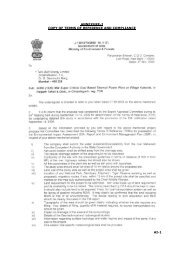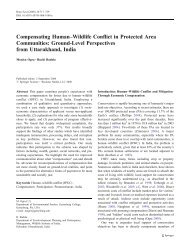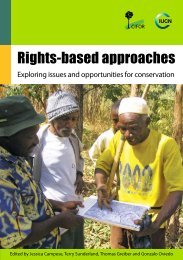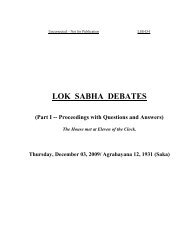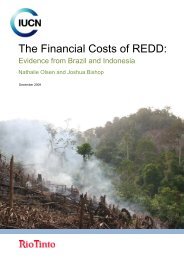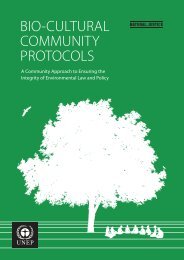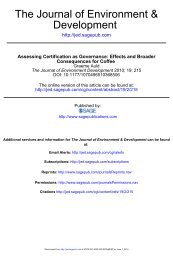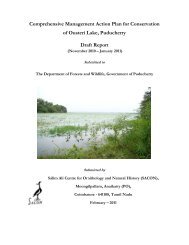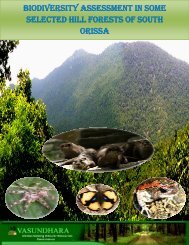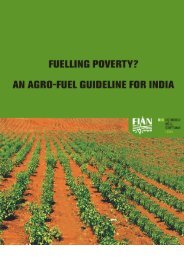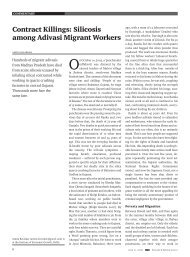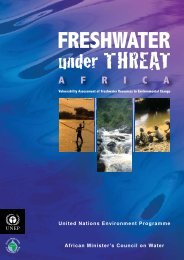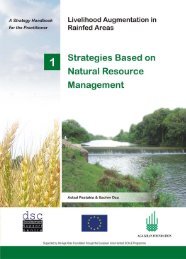Integrated River Basin Planning – Replicable ... - India Water Portal
Integrated River Basin Planning – Replicable ... - India Water Portal
Integrated River Basin Planning – Replicable ... - India Water Portal
You also want an ePaper? Increase the reach of your titles
YUMPU automatically turns print PDFs into web optimized ePapers that Google loves.
<strong>Integrated</strong> <strong>River</strong> <strong>Basin</strong> <strong>Planning</strong>: <strong>India</strong> and the EU share experience on policy and practice<br />
Prioritisation of Issues<br />
system that can be reused to reexamine the problems and, importantly, to measure<br />
the effects of actions taken to address the problems.<br />
6 Prioritisation<br />
of Issues<br />
6.1 Methodology<br />
The general philosophy in the process towards <strong>Integrated</strong> <strong>Water</strong> Resources<br />
Management is, under the given conditions, to establish a balance between the<br />
requirements relating to water, of the economic/social environment and of the<br />
effects of human activities on the water resource.<br />
This balance will be established through a system of management functions<br />
targeted to solve the identified problems of the resource with respect to their<br />
importance. With a technical description of the current situation of the resources<br />
and their exploitation (availability/quality/demand/pollution), a general analysis of<br />
the current problems of the various management levels as well as a systematic<br />
analysis of the importance of the basic problems, it will be possible to identify the<br />
relevant measures for establishment/improvement of the management functions<br />
that will form the contents of an action plan.<br />
In short: «Knowing where you are in order to find out where you are going or<br />
where you can go».<br />
The state is subdivided into hydrographical basins, but the method can also be<br />
used to assess the issues at the national level as a whole. Relevant issues are<br />
then assessed and ranked (prioritised) against a set of predefined criteria used<br />
to assess the importance of a given situation. In order to structure the issues,<br />
the method operates with impact issues relating to quantity and quality of the<br />
resource, user requirement issues and risks imposed by the resource.<br />
This tool was used in the Pamba <strong>River</strong> <strong>Basin</strong> to reach a consensus on the priority<br />
issues through extended dialogue and discussions. Representatives drawn from<br />
the water resource department (irrigation, groundwater), agriculture department,<br />
forestry, pollution control board, water service delivery agencies (Kerala <strong>Water</strong><br />
Authority), electricity department, local self government departments, district<br />
collectors, other technical departments, bio-diversity board, NGOs and CBOs<br />
across the basin discussed various issues that are relevant to IWRM and ranked<br />
them based on their experience. The participants were taken through the key<br />
issues described in the tool and asked to consider the cause of the problem<br />
based on their first-hand experience and collectively rank them on a five-step<br />
scale (light problem, problem, important problem, very important problem and<br />
major problem). The open debate and collective ranking process neutralized<br />
the probability of individual biases influencing the ranking. A total of 104 water<br />
resources issues were ranked and thereby prioritised as part of a participatory<br />
consultation session performed in May 2010. Out of the 104 issues ranked 51<br />
issues were assessed to be of different degree of importance. The results are<br />
given in the following sections and a full list of the 104 issues ranked is given in<br />
Annex 2<br />
6.2 Impact issues affecting quantity<br />
and quality of the Pamba water<br />
resources<br />
Table 7 below shows the identified and ranked impact issues to be of importance<br />
in the Pamba <strong>River</strong> <strong>Basin</strong>. With respect to surface water, it appears that issues<br />
of major problems in the basin consist of reduced availability, water loss,<br />
turbidity, pathogenic contamination and organic pollution caused by sand<br />
mining, encroachment, sedimentation of reservoirs and excreta. Impact issues of<br />
importance for groundwater consist of reduced availability due to climate change<br />
and contamination of the quality of the resource due to excreta.<br />
Table 7<br />
<strong>Water</strong> resource issues and causes<br />
In order to prioritise the water resources issues for the Pamba <strong>Basin</strong>, the <strong>Water</strong><br />
Resources Assessment Method (WRIAM) was applied during a stakeholder<br />
working session conducted in May 2010. The WRIAM method was developed as<br />
part of a project concerning IWRM in Burkina Faso and has since been applied<br />
in more than 20 countries as part of their IWRM process. The method has been<br />
conceived to allow the attribution of reasonably qualified quantitative values to<br />
more or less subjective judgements, thus offering at the same time a monitoring<br />
<strong>Water</strong> Resource Issues<br />
Reduced availability and loss of the water resource<br />
Turbidity<br />
Pathogenic and organic pollution<br />
Resource availability and quality do not meet the demand for<br />
ecosystems and pilgrims<br />
Soil erosion and loss of crops<br />
Causes<br />
Sand mining<br />
Encroachment<br />
Sedimentation of reservoirs<br />
Contamination from excreta<br />
Climate change<br />
Floods and intensive pluviometry<br />
40 41



